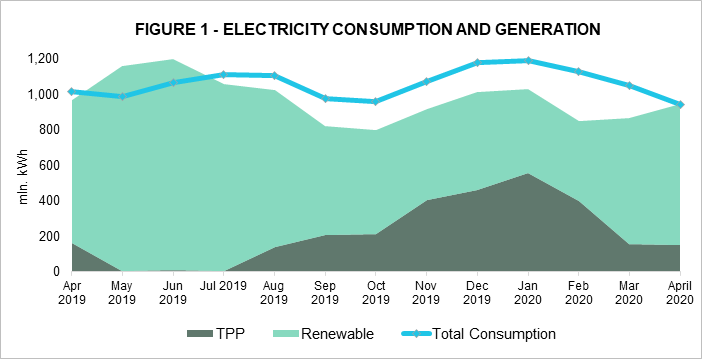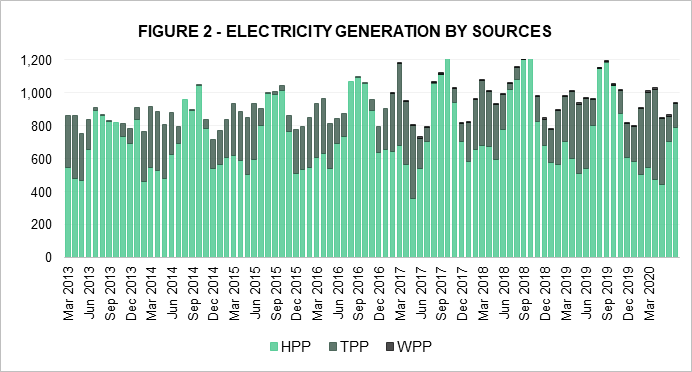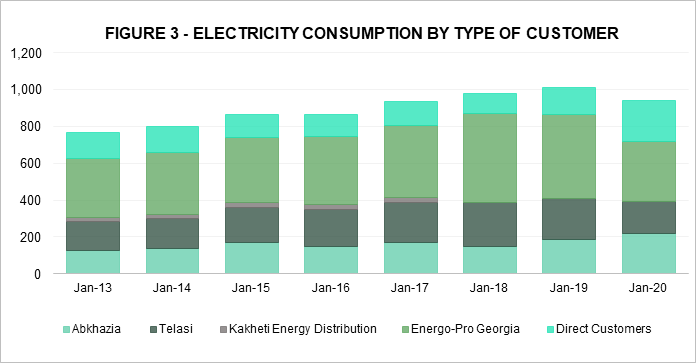THE GAP CLOSES
In April 2020, total generation and consumption nearly balanced (944 mln kWh of generation and 941 mln kWh of consumption), with power generation exceeding consumption by only 3 mln. kWh (corresponding to 0.3% of total generation: Figure 1). This occurred due to the simultaneous decrease in total consumption (7%) and total generation (2%). Interestingly, over the same period, wind power generation increased by a remarkable 23% compared to April 2019.
One year before, in April 2019, the difference between total generation and consumption had instead resulted in a deficit of 45 mln. kWh, approximately 5% of the total generation for the month. The closure of the gap between consumption and generation is clearly the result of the combination of seasonal factors and of the COVID-19 lockdown of the economy that influenced heavily the energy market.
As usual, most generation came from hydro power plants. In April 2020, hydro power (HPP) generation amounted to 787 mln. kWh (84% of total), while thermal power (TPP) generation was 148 mln. kWh (16% of total), and wind power (WPP) generation was 8 mln. kWh (1% of total) (Figure 2).
Total electricity demand came from: Energo-Pro Georgia1 (34% - 324 mln. kWh), Telasi (18% - 170 mln. kWh), Abkhazia (24% - 222 mln. kWh), and direct customers (24% - 223 mln. kWh) (Figure 3).
Annual demand from Energo-Pro Georgia and Telasi decreased by 29% and 23% respectively, while consumption in Abkhazia increased by a staggering 18%. Furthermore, consumption by direct customers increased by 55%.2
IMPORTS DECLINE
Thanks to the closure of the generation-consumption gap, electricity imports substantially decreased in April 2020 (Figure 4). Georgia imported 36 mln. kWh of electricity (-55% compared to April 2019) 82% of which came from Russia, while the remaining 18% was provided by Azerbaijan. Over the same period, 6 mln. kWh of electricity was exported to Azerbaijan. This month there was no electricity transit to other countries.
The weighted average electricity import price in April 2020 decreased by 11% in USD, on an annual basis, while the increase of 5% in GEL was due to the depreciation of the National Currency (from 5¢ or 13.46 tetri per kWh in April 2019 to 4.43¢ or 14.2 tetri per kWh in April 2020) (Figure 5). The weighted average import price increased by 18% in USD and by 24% in GEL on a monthly basis (import price was 3.75¢ or 11.40 tetri per kWh in March 2020). The weighted average electricity exports price in April 2020 was 5.46¢ or 16.61 tetri per kWh. As for export prices, they stood at 5.5¢ or 17.61 tetri per kWh in April 2020.
We expect the positive generation-consumption gap to persist over the coming months, as the expected seasonal increase in generation will exceed the increase in consumption as the economic effects of the COVID-19 crisis slowly fade away.
1 Energo-Pro Georgia acquired Kakheti Energy Distribution in September 2017.
2 It has to be noted that with the market reopening since May 2019, large customers started buying their electricity on the market as direct customers. This is the main reason behind the decrease in electricity consumption from Energo-Pro Georgia and the increase in direct consumption.





















Comments